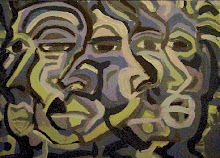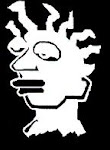 The common assumption is that almost everyone sees objects in the same way.
The common assumption is that almost everyone sees objects in the same way.But SeeNew points out an example of different perceptions of the same object based on different perspectives.
can be interpreted as having a "different" expression based on the angles which one views it - even though the mask itself has a static expression.
So... if one person views someone else's face at eye level - that would be a "normal" expression (neither antagonistic nor gleeful).
If one views the same individual from below (with the seemingly larger eyes, open nostrils and terse lips) - the person being viewed would seem more threatening and authoritative.
If one is taller than the person being viewed - their face may come across as more passive, submissive and less threatening.
Interesting...
Maybe this is why politicians convey different messages based on whether they are speaking from a podium, walking and talking at eye level, or are being looked down upon in an arena. Maybe this is why preachers speak from above their parishioners or students are seated while listening to teachers.
Maybe this is why parents seem threatening when admonishing young children - but less so when a child reaches adulthood.
Maybe it's not the size of an individual that is seen as submissive or dominant - but their projected image.















2 comments:
What continues to puzzle and amaze me mayne, is, how could the medieval japanese artisan have known/understood/crafted such an artifact? A static object with dynamic behavioral properties.
Beyond this, that there was an entire well established culture of competency focused on theatrically exploiting such subtle craft.
@ SeeNew - Decades, centuries and eras of knowledge learned, re-learned and forgotten by each culture and then shifted to the next "dominant" culture.
I think this is why we humans are always "reinventing the wheel" in our thinking process.
Post a Comment